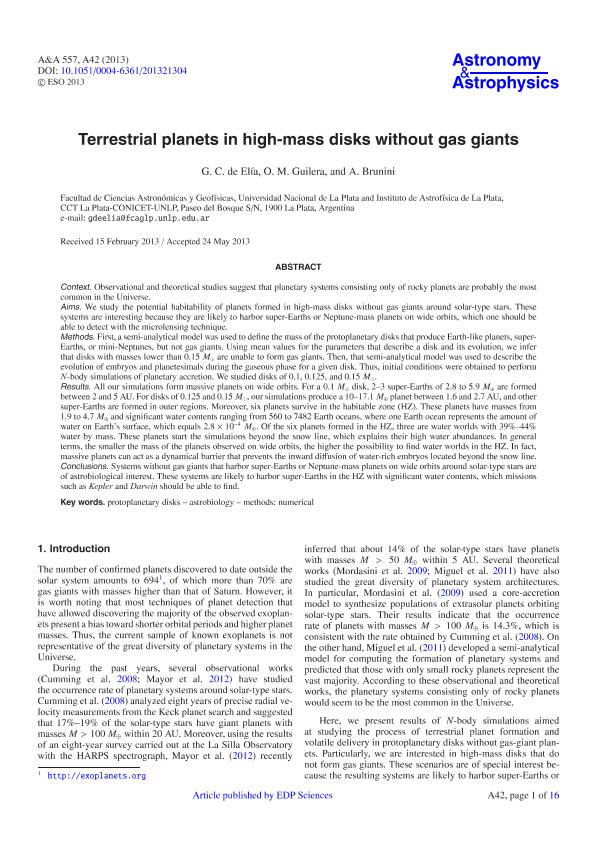Artículo
Terrestrial planets in high-mass disks without gas giants
Fecha de publicación:
09/2013
Editorial:
Edp Sciences S A
Revista:
Astronomy And Astrophysics
ISSN:
0004-6361
Idioma:
Inglés
Tipo de recurso:
Artículo publicado
Clasificación temática:
Resumen
Context. Observational and theoretical studies suggest that planetary systems consisting only of rocky planets are probably the most common in the Universe. Aims. We study the potential habitability of planets formed in high-mass disks without gas giants around solar-type stars. These systems are interesting because they are likely to harbor super-Earths or Neptune-mass planets on wide orbits, which one should be able to detect with the microlensing technique. Methods. First, a semi-analytical model was used to define the mass of the protoplanetary disks that produce Earth-like planets, superEarths, or mini-Neptunes, but not gas giants. Using mean values for the parameters that describe a disk and its evolution, we infer that disks with masses lower than 0.15 M are unable to form gas giants. Then, that semi-analytical model was used to describe the evolution of embryos and planetesimals during the gaseous phase for a given disk. Thus, initial conditions were obtained to perform N-body simulations of planetary accretion. We studied disks of 0.1, 0.125, and 0.15 M. Results. All our simulations form massive planets on wide orbits. For a 0.1 M disk, 2–3 super-Earths of 2.8 to 5.9 M⊕ are formed between 2 and 5 AU. For disks of 0.125 and 0.15 M, our simulations produce a 10–17.1 M⊕ planet between 1.6 and 2.7 AU, and other super-Earths are formed in outer regions. Moreover, six planets survive in the habitable zone (HZ). These planets have masses from 1.9 to 4.7 M⊕ and significant water contents ranging from 560 to 7482 Earth oceans, where one Earth ocean represents the amount of water on Earth’s surface, which equals 2.8 × 10−4 M⊕. Of the six planets formed in the HZ, three are water worlds with 39%–44% water by mass. These planets start the simulations beyond the snow line, which explains their high water abundances. In general terms, the smaller the mass of the planets observed on wide orbits, the higher the possibility to find water worlds in the HZ. In fact, massive planets can act as a dynamical barrier that prevents the inward diffusion of water-rich embryos located beyond the snow line. Conclusions. Systems without gas giants that harbor super-Earths or Neptune-mass planets on wide orbits around solar-type stars are of astrobiological interest. These systems are likely to harbor super-Earths in the HZ with significant water contents, which missions such as Kepler and Darwin should be able to find.
Palabras clave:
Protoplanetary Disks
,
Astrobiology
,
Numerical Methods
Archivos asociados
Licencia
Identificadores
Colecciones
Articulos(IALP)
Articulos de INST.DE ASTROFISICA LA PLATA
Articulos de INST.DE ASTROFISICA LA PLATA
Citación
de Elia, Gonzalo Carlos; Guilera, Octavio Miguel; Brunini, Adrian; Terrestrial planets in high-mass disks without gas giants; Edp Sciences S A; Astronomy And Astrophysics; 557; A42; 9-2013; 1-16
Compartir
Altmétricas




